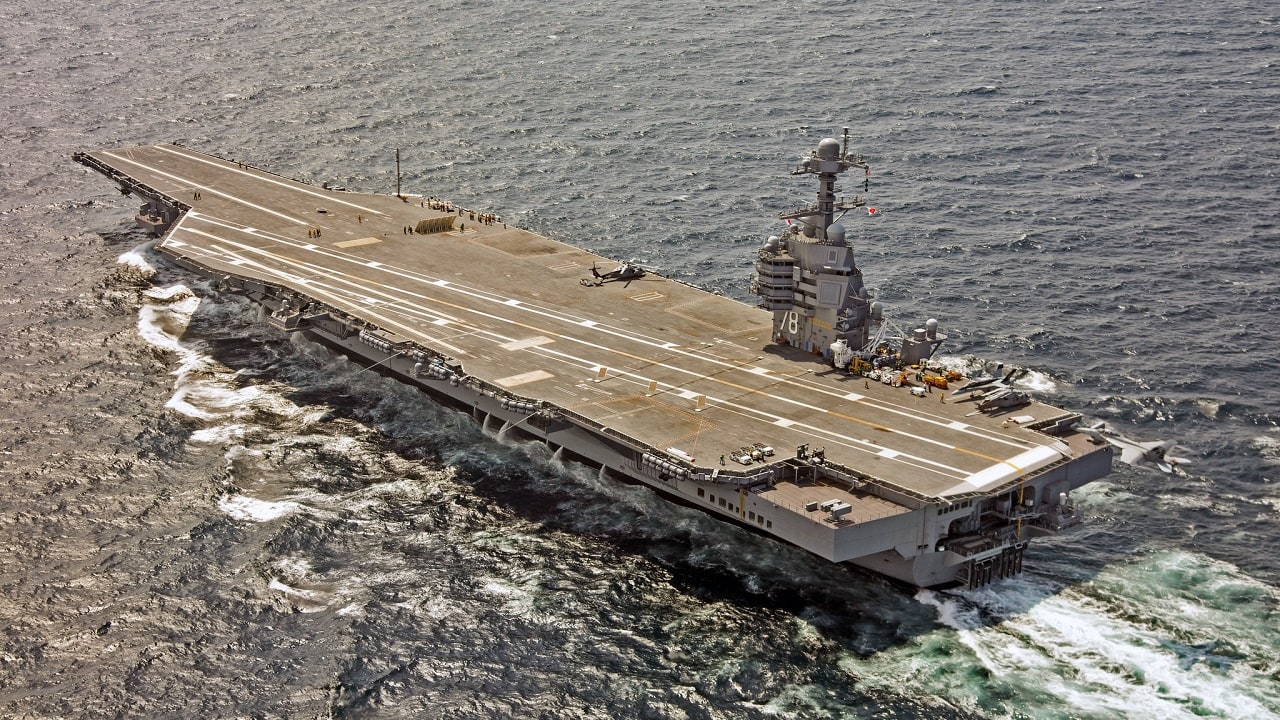U.S. Navy brass and sailors aboard the new USS Gerald R. Ford supercarrier are enthused. The carrier just passed an important milestone. The Gerald R. Ford was certified “green” on the Combat Systems Operational Readiness Exercise (CSORE), the Department of Defense said on August 4. This evaluation determines how well the ship’s combat systems and its personnel react to dangers from a notional enemy. This exercise tested the ability to take out threats from the air, whether from manned or unmanned aircraft, or drone ships on the water.
Weapons Working to Full Capacity
The ship’s Close-In Weapons System (CIWS) and MK-38 25 millimeter guns blasted their way through the drill and showed evaluators that the Ford means business. The crew worked to prep the guns, excelled at loading them quickly, and displayed top-notch marksmanship.
Passing the Test Gives Sailors Confidence
Gunner’s Mate 2nd Class Hector Mejia, the lead petty officer of weapons in the section, told Defense Visual Information Distribution Service that “Being a part of CSORE with the MK-38’s and getting experience everything first-hand was amazing,” Mejia said. “My proudest moment was watching the MK-38’s operate as designed and destroy surface contacts with speed and precision of action.”
Good News Counteracts Disappointment of Delays
While the lead ship of the Ford-class has endured a year of delays on its timeline to finally deploy, the CSORE drill should give the officers and sailors confidence that the ship will be ready to go this fall. The next step will be the Ford participating in a multi-national exercise. This will show off flight deck operations with a partial carrier air wing on board. The drills will include activities with carriers from France and the United Kingdom along with seven other navies.
Ford Passed Other Tests
While the carrier was commissioned in 2017, it has done well in months of shock trials that measured its ability to function while sailing next to large blasts from simulated combat explosives. The Ford held up well during three 40,000-pound underwater explosions in August of last year.
Get Those Fighters in the Air
The Ford will test its electromagnetic catapult in the next multinational drill. This will enable the Ford to conduct more sorties a day compared to other U.S. carriers. There will be at least 4,500 crew members and a contingent helping flight deck operations that include 75 aircraft. F-35C Lightning IIs and F/A-18E/F Super Hornets will fly missions 24-7 when the carrier is fully deployed. The catapult requires fewer sailors and will hopefully have fewer maintenance needs, which will ultimately save the Navy money.
Defense Against Carrier Killer Missiles
Over 1,000 feet in length, the Ford will have two nuclear reactors and four shafts that can power speeds of up to 30-plus knots. Armaments besides the aforementioned deck guns and CIWS include the Evolved Sea Sparrow Missile anti-aircraft system and the Rolling Airframe Missile to defend against anti-ship missiles and “carrier killing” launches.
Long Time Coming
Once the upcoming exercise with Britain, France, and other countries goes well, the Navy can breathe a sigh of relief. It has been a long road, but the Ford attempted to bring to bear multiple technologies so the Navy should be given credit for hanging in there under adverse conditions and much belly-aching from Congress and the media.
Having 11 aircraft carriers in service will be an optimum scenario for the Navy until one retires. China plans to have six carriers in the coming decades, so it’s time to keep leaping ahead of Beijing. The future carriers of the Ford-class will use the Gerald R. Ford’s acquisition issues to focus on lessons learned so mistakes in manufacturing will not be repeated. The other good news is that judging from the latest weapons evaluation, the crew of the Ford should have higher morale going into full deployment later this year. The ship should be ready for combat patrols at a time when a two-front conflict with China and Russia is plausible.
Now serving as 1945’s Defense and National Security Editor, Brent M. Eastwood, PhD, is the author of Humans, Machines, and Data: Future Trends in Warfare. He is an Emerging Threats expert and former U.S. Army Infantry officer. You can follow him on Twitter @BMEastwood.

